Human FcRn Is a Two-in-One Attachment-Uncoating Receptor for Echovirus 18.
Chen, X., Qu, X., Liu, C., Zhang, Y., Zhang, G., Han, P., Duan, Y., Li, Q., Wang, L., Ruan, W., Wang, P., Wei, W., Gao, G.F., Zhao, X., Xie, Z.(2022) mBio 13: e0116622-e0116622
- PubMed: 35862785
- DOI: https://doi.org/10.1128/mbio.01166-22
- Primary Citation of Related Structures:
7XXA, 7XXG, 7XXJ - PubMed Abstract:
Virus-receptor interactions determine viral host range and tissue tropism. CD55 and human neonatal Fc receptor (FcRn) were found to be the binding and uncoating receptors for some of the echovirus-related enterovirus species B serotypes in our previous study. Echovirus 18 (E18), as a member of enterovirus species B, is a significant causative agent of aseptic meningitis and viral encephalitis in children. However, it does not use CD55 as a critical host factor. We conducted CRISPR/Cas9 knockout screening to determine the receptors and entry mechanisms and identified FcRn working as a dual-function receptor for E18. Knockout of FCGRT and B2M , which encode the two subunits of FcRn, prevented infection by E18 and other echoviruses in the same physiological cluster. We then elucidated the underlying molecular mechanism of receptor recognition by E18 using cryogenic electron microscopy. The binding of the FCGRT subunit to the canyon region rotates the residues around the pocket, triggering the release of the pocket factor as observed for other enterovirus species B members. IMPORTANCE E18 is a member of enterovirus species B. As one of the most common enterovirus serotypes in nonpolio enterovirus detection, it easily infects children and causes various clinical symptoms. Aseptic meningitis and viral encephalitis are the most commonly reported syndromes associated with E18. No effective antiviral drugs or approved vaccines are available. Previous studies showed that CD55 and FcRn were the binding and uncoating receptors for some echoviruses. However, we found that CD55 is not the critical host factor for E18. Thus, we want to determine the receptors and elucidate the entry mechanism of E18. Our findings reveal that FcRn is a two-in-one attachment-uncoating receptor for E18.
Organizational Affiliation:
Beijing Key Laboratory of Pediatric Respiratory Infection Diseases, Key Laboratory of Major Diseases in Children, Ministry of Education, National Clinical Research Center for Respiratory Diseases, Research Unit of Critical Infection in Children, Chinese Academy of Medical Sciences, 2019RU016, Laboratory of Infection and Virology, Beijing Pediatric Research Institute, Beijing Children's Hospital, Capital Medical University, National Center for Children's Health, Beijing, China.


















